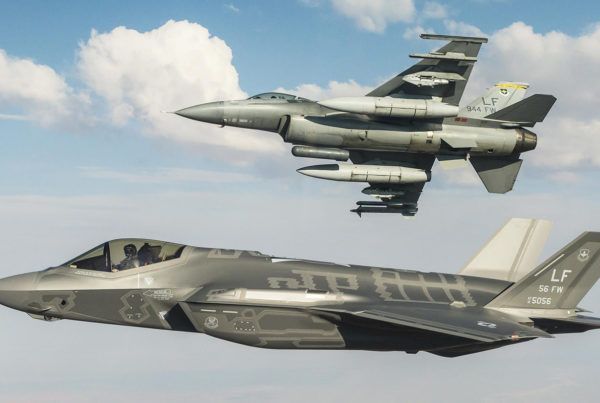 In a July 20, 2011 letter to West Valley Partners, U.S. Sen. John McCain pledges his continued support for the F-35 and Luke AFB as a major training base for the newest fighter jet in the country’s defense arsenal.
In a July 20, 2011 letter to West Valley Partners, U.S. Sen. John McCain pledges his continued support for the F-35 and Luke AFB as a major training base for the newest fighter jet in the country’s defense arsenal.
In a Sept. 8, 2011 letter to Secretary of the Air Force Michael Donley, McCain sets forth his concerns about transfers of F-16 squadrons from Luke to Holloman AFB, N.M., given that F-16 pilots will possibly face scheduling conflicts with Army and joint forces when it comes to use of the White Sands Missile Range at Holloman.
McCain, in his letter to Donley, asks that the Air Force consider the costs associated with the planned move of four F-16 squadrons from Luke to Holloman, and consider the savings from not duplicating facilities, and the problems that may occur with the move, not the least of which is insufficient housing for military personnel and their families. McCain is also concerned that the White Sands Missile Range may be limited in its training capability.
Both letters are printed in their entirety as follows:
U.S. Sen. John McCain wrote the following letter to West Valley Partners, c/o Chairman, Mayor Elaine Scruggs, July 20, 2011.
I want to take a moment to thank you for your unwavering support of Luke Air Force Base and to update you on the Department of the Air Force’s plans to bring the F-35 Lightning II to Luke AFB. Two recent decisions by the Secretary of the air Force reaffirmed for me the Air Force’s support for Luke AFB, as well as their awareness of the concerns of the local community.
First, despite the cost overruns and production delays encountered in the F-35 program over the last two years, in June the Air Force reaffirmed its plan to station the first F-35 at Luke AFB by August of 2013. This confirmation of the Air Force’s decision to make Luke a major training base for the F-35, as Luke has been for the F-16, demonstrates that the Air Force fully recognizes the critical value of a base that is supported by a strong community combined with a premier, dedicated pilot training range that cannot be equaled anywhere in the country.
The Air Force also recognizes that they, along with the Marine Corps and the Navy, desperately needs the F-35 fighter to be delivered on time and within a cost that can be sustained during what may be a period of declining defense budgets. I will do everything I can to both constrain the cost growth and schedule delays on the F-35 in addition to ensuring that this much needed aircraft delivers on its promises to the Air Force and finds it new home at Luke AFB. For the benefit of our military and our country, we must ensure that the F-35 program can deliver the numbers of aircraft and the capability required to meet the critical war-fighting needs of the military. We cannot afford to mismanage or fail in this critical acquisition program or continue on a path that future defense budgets will not be able to sustain.
The second Air Force decision announced in June concerned the planned transfer of two F-16 squadrons from Luke AFB to Holloman AFB, New Mexico. This transfer was originally planned to commence in October of 2011. I have questioned the Air Force on the rationale for this decision in light of our current budget climate and will continue to critically asses the plans. The Air Force decision to delay the move by 18 months is consistent with the concerns you have raised about a significant reduction to air operations at Luke AFB over an extended period of time. I know we share the view that Luke AFB has the capability to support multiple F-35 pilot training squadrons as well as four squadrons of F-16 aircraft without a detrimental impact to military training or the local community. As such, I do not support spending defense funds only for the purpose of spreading the wealth of fighter aircraft. I will continue to argue that the Air Force’s priority should be to maintain F-16 pilot training at Luke and take advantage of the priceless Barry M. Goldwater Range, which offers the best capabilities with the most efficient use of taxpayer dollars.
Moving forward, I will continue to insist that the Department of Defense bring down the costs of the F-35 and meet the aircraft acquisition goals that are critical to the military services. I am also aware of the delays in the completion of an environmental impact statement (EIS) for Luke AFB, but I believe these delays will not affect the arrival date of the first three F-35 squadrons. I am committed to ensure that the Air Force conducts a comprehensive EIS review that will address the legitimate concerns of the communities affected by Luke AFB.
The outstanding support your organization provides our military members at Luke AFB is invaluable. I am proud to represent you.
Dear Secretary Donley:
I write to you today about an issue that could potentially have a negative impact on Air Force pilot training, military readiness and our overall national security. I want to be clear that this correspondence should be in no way viewed as me seeking preferential treatment for the State of Arizona. I expect only such action which is in the best interests of the country.
I am concerned about a wide range of issues related to the Air Force plan to transfer two F-16 training squadrons currently assigned to Luke AFB, Arizona, to Holloman AFB, New Mexico. As you know, the Air Force recently decided to delay these unit transfers by about 18 months to mid-2013 in order to reduce impacts to pilot production during a critical phase in the upcoming year. I believe the facts warrant further consideration of the plan.
The Air Force recently estimated that the military construction costs related to the transfer would be $47 million to duplicate F-16 pilot training capacity at Holloman that already exists at Luke. I believe we have an obligation to be stewards of the taxpayer’s money and seek savings wherever they can be realized. This planned transfer appears to run counter to this obligation.
I believe that Luke AFB and the Barry M. Goldwater Range (BMGR) have the capacity to support both the operation of the four U.S. F-16 training squadrons currently assigned to Luke, as well as multiple F-35 Lightning 11 squadrons. Both types of aircraft train primary for air-to-ground missions. In fact, Luke has hosted far more F-16 training aircraft in the recent past – more than 200 F-16s on the flight line – than is currently envisioned even if the F-35 that replaces it is delivered on time and in the quantities called for under existing plans and the remaining F-16s at Luke are phased out slowly over time.
My staff has been told that the rationale for the F-16 transfer form Luke is at least partially supported by a desire of the Air Force to maintain air-to-ground training access to White Sands Missile Range from Holloman AFB, despite the fact that the Department of the Army has insisted on part of its formal range management agreement with the Air Force that White Sands will continue to be prototyped to support a robust schedule of Army and Joint missile testing. As a result, F-16 pilot training for squadrons transferred to Holloman AFB will be required to deconflict schedules around higher-priority Army and Joint missile tests, and in addition will also need to share airspace and bombing ranges with Army Apache helicopter training based at Fort Bliss, foreign military training for the German Air Force, and dissimilar unmanned aerial vehicle pilot training from UAV units assigned to both Holloman AFB and Fort Bliss. Repeated studies by both the Air Force and Navy of competing uses at White Sands point to the potential for significant attrition of the airspace available for training student pilots, which could result in a negative impact on F-16 pilot production and slippage in the F-16 training pipeline.
Given these competing users and higher priority on testing at White Sands, will there be routine and predictable access to dedicated airspace and the air-to-ground range in order to provide the flexibility needed for a dynamic training syllabus? Delays, cancellation of planned flights or shifting the training schedule due to emerging requirements often causes flight training preparation to have to be repeated from the beginning. First-priority for training range access exists at BMGR, while in contrast, it appears that the Air Force will have access to the White Sands range only during periods when pilot training operations do not conflict with a myriad of Army and Joint test activities.
As you know, based on the recent direction by the President to reduce the Defense budget by at least $400 billion over the next twelve years, the Air Force is currently undergoing a through strategic review of all aspects of its budget and operations to find efficiencies and savings. At this critical point, I believe the Air Force can still afford the costs involved in duplicating existing F-16 flight training infrastructure and capacity, adding unnecessary airspace and range challenges, and the potential for negative impacts on flight training productivity in order to preserve access to the White Sands range. Access by the Air Force to White Sands is already assured by a multi-service agreement, and to the extent the Air Force desires to exercise those rights from time-to-time, I believe it can do so most efficiently through rotational training. Given the competing priorities and users at White Sands. I do not believe that it is possible to duplicate the existing training capacity at the Barry M. Goldwater Range at the White Sand Missile Range.
I urge you to consider the proposed F-16 transfer in light of the significant additional costs associated with duplicating the infrastructure, the personnel and operation and maintenance costs associated with the move, the potential for negative training impact, including whether there will be negative impacts on pilot training production, the concerns raised about the shortage of available housing for transferred military and civilian personnel, and the potential for conflicts over access to the airspace and capacity for air-to-ground training at White Sands Missile range. Additionally, I request that you also carefully weigh how looming Defense budget cuts will affect the jF-35 program in terms of its planned delivery schedule and ultimate numbers of aircraft to be procured before deciding whether to go forward with, and the time of, proposed transfers of F-165 from Luke AFB.
This article is made available with permission of Pueblo Publishers, Inc.








